The word “Jyotirlinga” comes from Sanskrit where “Jyoti” meaning light and “Linga” referring to the symbolic form of Lord Shiva. Thus, a Jyotirlinga is a pillar of divine radiance, where Shiva is believed to have manifested as an infinite beam of light.
In Sanatana Dharma, these 12 sacred sites are not merely temples — they are powerful spiritual centers, each holding a unique legend and divine presence. In Shaivism, they represent the limitless, formless nature of Shiva, transcending the material world.
These “Pillars of Light” or Jyotirlingas are spread across Bharat, forming a sacred map of devotion, energy, and history. This blog explores their spiritual significance, mythological origins, and cultural legacy that continues to illuminate the hearts of millions.
Table of Contents
The Legend Behind the Jyotirlingas
The story of the Jyotirlingas has its roots in one of the most fascinating episodes from the Shiva Purana. It’s not just a legend — it’s a cosmic reminder of Lord Shiva’s boundless nature.
According to the tale, there was once a heated debate between Brahma, the creator, and Vishnu, the preserver. Both wanted to prove who was the supreme being of the universe. Their argument grew so intense that balance itself seemed at risk.
That’s when Lord Shiva decided to intervene. To shatter their pride and reveal the truth, he appeared in a spectacular way — manifesting as an endless pillar of light that stretched beyond imagination, with no beginning and no end. This was the Jyotirlinga — a radiant symbol of Shiva’s infinite, formless energy.
He challenged Brahma and Vishnu:
“Find either the top or bottom of this pillar, and the one who succeeds will be declared supreme.”
Vishnu took the form of Varaha (a boar) and dug deep into the earth to find the base, while Brahma flew upwards on his swan in search of the top. Ages passed, but neither could reach their goal. Vishnu accepted his defeat and bowed in reverence, but Brahma lied. He claimed to have seen the top, even bringing a flower (Ketaki) as a false witness.
Shiva, enraged by Brahma’s dishonesty, emerged from the pillar and cursed him:
“You shall never be worshipped in temples on Earth.”
Thus, the Jyotirlinga became a symbol not just of Shiva’s power, but also of truth, humility, and the infinite. It reminds devotees that the divine cannot be measured, defined, or reached through ego.
Each of the twelve sites where Shiva is believed to have appeared as this pillar of light became a Jyotirlinga shrine, sanctified by divine presence and ancient stories.
The 12 Jyotirlingas – Sacred Geography of Light
When you travel across India, you’ll find that the twelve Jyotirlingas aren’t just temples — they feel like whispers of something divine. Each one has its own story, its own energy, and when you step inside, it’s as if time slows down for a moment.
People believe these are the very places where Lord Shiva revealed himself as a pillar of endless light, showing that the universe itself is his form. That’s why millions of devotees still keep these shrines close to their hearts.
Let’s begin with the very first Jyotirlinga, the one that feels like the starting point of this sacred journey:
1. Somnath (Gujarat)
Somnath is not just a temple standing by the sea — it’s a lesson in faith. Imagine waves crashing against the shore, and right there, this shrine rising proudly, as if saying: “No matter how many times you try to bring me down, I will stand again.”
This is exactly what Somnath has done through history. It has been destroyed, rebuilt, and attacked again — yet it always comes back stronger. And maybe that’s why people feel such deep emotion here: Somnath doesn’t just belong to history, it belongs to resilience.
There’s also a touching legend tied to it. The Moon God, Soma, once lost his shine after being cursed. Imagine a moon without glow — the world itself would feel incomplete. So Soma prayed with all his heart to Lord Shiva here. Moved by his devotion, Shiva lifted the curse and restored his brilliance. And that’s how Somnath became a symbol of healing, renewal, and unshakable divine protection.

Image Credit: Different Different Books, CC BY-SA 4.0 via Wikimedia Commons
https://commons.wikimedia.org/wiki/File:SOMNATH_TEMPLE.jpg
2. Mallikarjuna (Andhra Pradesh)
If Somnath teaches us about resilience, Mallikarjuna feels like home. Nestled on the quiet Shri Shaila mountain, with the Krishna River gliding softly below, this temple doesn’t just stand — it breathes with warmth. When you’re here, it’s almost like the mountain cradles you while the river hums a lullaby.
What makes Mallikarjuna truly beautiful is that it’s not just Shiva you meet here. It’s Shiva with Parvati — together, side by side. Very few temples hold both the divine masculine and feminine in the same sanctum. And that changes everything. Because when you stand before the deity, you’re reminded that life itself is balance: strength and compassion, stillness and flow.
People believe that anyone who bows here with sincerity leaves lighter — as if their sins are washed away by the river and their soul gets a step closer to freedom. But beyond beliefs, Mallikarjuna feels like a place where your heart simply loosens its knots. You breathe easier. You feel forgiven. You feel… whole.
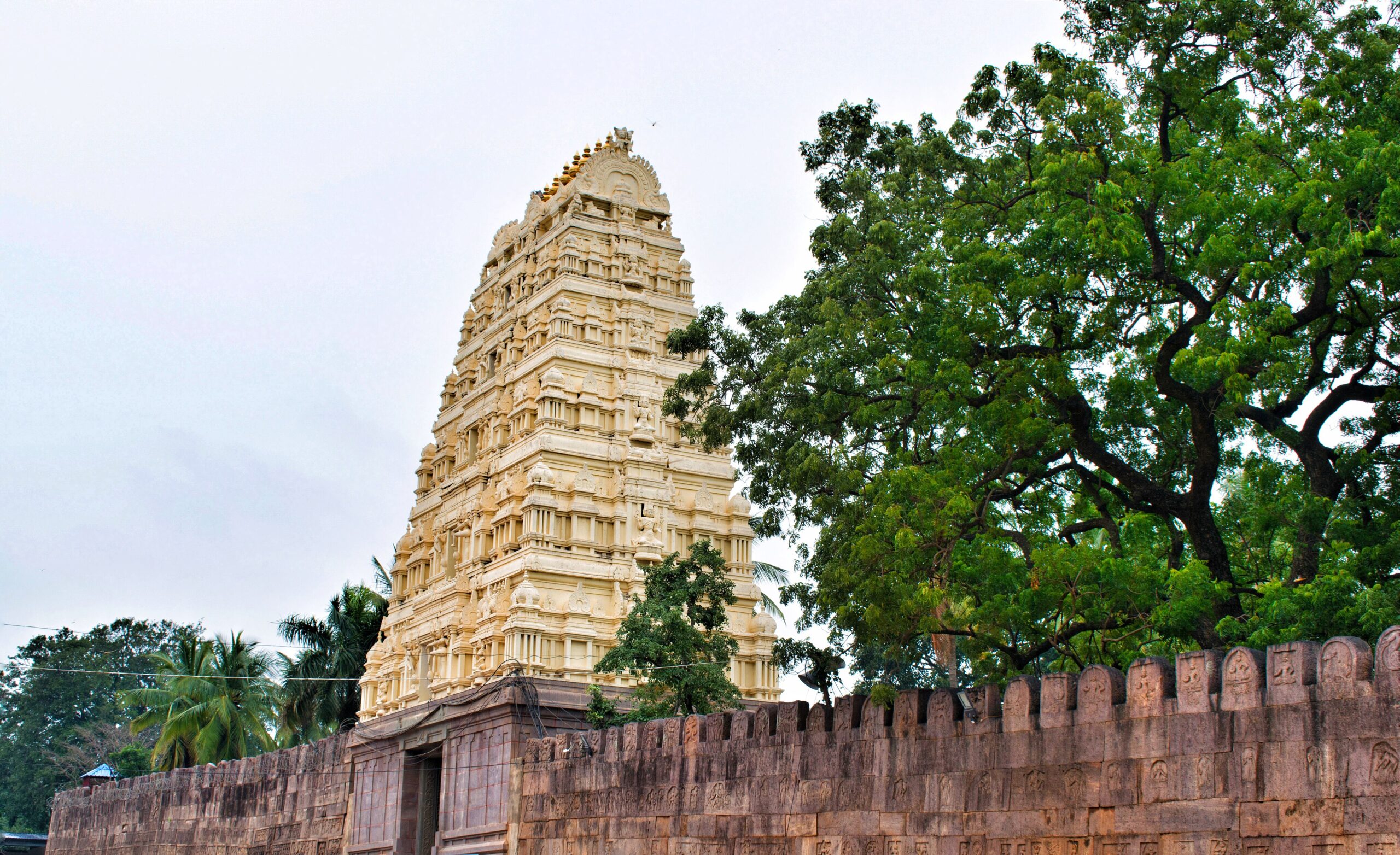
Image Credit: Arpita Tripathy, CC BY-SA 4.0 via Wikimedia Commons
https://commons.wikimedia.org/wiki/File:Mallikarjuna_Temple,_Sri_Sailam.jpg
3. Mahakaleshwar (Madhya Pradesh)
Ujjain is no ordinary city — it feels like it carries time itself in its breath. And right in the heart of it stands the Mahakaleshwar temple, where Shiva is worshipped not just as a god, but as Mahakaal — the Lord of Time and Death.
What makes this shrine unique is that the Linga here faces south, a direction deeply linked with death and the afterlife in Hindu belief. It’s almost as if Shiva, in his most powerful form, is sitting here to remind us that everything — power, wealth, even life itself — eventually bows to time.
The most unforgettable experience at Mahakaleshwar is the Bhasma Aarti. Imagine the break of dawn, chants filling the air, and the sacred Linga being anointed with fresh ash — the very symbol of life’s impermanence. Being present there gives you goosebumps, because it’s not just a ritual; it feels like a direct conversation with eternity.
People leave Ujjain with a quiet realization: we’re all racing against time, but in the presence of Mahakaal, that rush softens. You walk away lighter, humbled, and strangely fearless.

Image Credit: Gyanendra_Singh_Chau…, CC BY 3.0 via Wikimedia Commons
https://commons.wikimedia.org/wiki/File:Shri_Mahakaleshwer_Temple_-_panoramio.jpg
4. Omkareshwar (Madhya Pradesh)
Imagine an island gently resting in the middle of the sacred Narmada River, shaped like the holy symbol ‘ॐ’. That’s Omkareshwar — a Jyotirlinga that feels less like a temple and more like a living mantra carved into the earth itself.
The moment you step onto Mandhata Island, there’s an energy that can’t quite be explained in words. The sound of the river, the sight of the island’s shape, and the quiet presence of the shrine all remind you of one truth — that Shiva’s essence is not just worshipped, it flows through the very fabric of creation.
Pilgrims who come here often take a parikrama (sacred walk) around the island, believing each step washes away burdens and brings the soul closer to purity. But beyond belief, the walk itself feels like meditation — the river by your side, the mountains watching over you, and the thought that you’re literally walking in the lap of the divine syllable, ॐ.
Omkareshwar isn’t just about seeing Shiva, it’s about feeling his cosmic energy with every breath you take on that island.

Image Credit: Deveshc92, CC BY 4.0 via Wikimedia Commons
https://commons.wikimedia.org/wiki/File:Omkareswar_Jyotirlinga.jpg
5. Kedarnath (Uttarakhand)
At an altitude of 11,755 feet, tucked deep in the Himalayas, lies Kedarnath, one of the most awe-inspiring Jyotirlingas. The journey here is not easy — pilgrims trek miles through rugged mountain paths or take a helicopter ride, but no matter how you arrive, the first glimpse of the temple against snow-capped peaks takes your breath away. It feels less like you’ve reached a shrine and more like you’ve walked straight into the lap of the divine.
According to legend, after the great war of Kurukshetra, the Pandavas came here seeking Lord Shiva’s forgiveness for the bloodshed of battle. But Shiva, testing their devotion, took the form of a bull and disappeared into the earth. It is believed that his hump reappeared here as the Kedarnath Jyotirlinga. The remaining parts of his body emerged in four other places, which together form the famous Panch Kedar (Tungnath, Rudranath, Madhyamaheshwar, and Kalpeshwar).
The temple itself has an incredible history. Said to be over a thousand years old, it is built from massive stone slabs that have withstood earthquakes and floods. Even the devastating 2013 floods, which wiped out the entire surrounding town, left the sanctum of Kedarnath miraculously untouched — a fact devotees often call proof of Shiva’s protection.
Being part of the Char Dham Yatra, Kedarnath is considered one of the most spiritually charged spots in India. Standing here, with icy winds brushing your face and the chants of “Har Har Mahadev” echoing in the thin mountain air, you realize why pilgrims call it a place where heaven and earth meet.

Image Credit: Pratha Bopche, CC BY-SA 4.0 via Wikimedia Commons
https://commons.wikimedia.org/wiki/File:Shri_Kedarnath_Jyotirlinga_Temple_02.jpg
6. Bhimashankar (Maharashtra)
Hidden away in the lush Sahyadri hills of Maharashtra, Bhimashankar feels like a temple wrapped in nature’s arms. To reach here, you often pass through thick forests alive with the sound of birds and the gentle rustling of leaves. It’s no wonder this shrine is loved not only by devotees but also by trekkers and nature lovers who find peace in its quiet surroundings.
The legend tied to this Jyotirlinga is as dramatic as the mountains themselves. It’s said that when the demon Tripurasura grew powerful and began tormenting the world, the gods prayed to Shiva for help. Answering their call, Shiva appeared here and defeated the demon, restoring balance. From that battle, the sacred Bhima River is believed to have sprung forth, flowing from the very land sanctified by his presence.
What makes Bhimashankar even more fascinating is that it’s not just a spiritual site — it’s also home to the Bhimashankar Wildlife Sanctuary, where you might spot the rare Giant Squirrel, locally called the Shekru. Standing here, surrounded by forests and rivers, the temple feels like a bridge between heaven and earth, where divinity and nature live side by side.
For pilgrims, Bhimashankar is a reminder that faith and strength can overcome even the darkest forces. For travellers, it’s a sanctuary where silence itself feels sacred.

Image Credit: Mechatron00, CC BY-SA 4.0 via Wikimedia Commons
https://commons.wikimedia.org/wiki/File:Temple_front_view3.jpg
7. Kashi Vishwanath (Uttar Pradesh)
If you ever step into Kashi — or Varanasi as most people call it — you’ll notice something right away. It doesn’t feel like any other city. There’s a certain energy here, a rhythm. It’s alive. Every street, every ghat, every prayer feels like part of a story that’s been going on for thousands of years.
At the heart of it is Kashi Vishwanath, one of the most sacred Jyotirlingas in India. For centuries, pilgrims have believed that dying in Kashi frees the soul from the endless cycle of birth and death. Even if you’re not here for that, people say that simply catching a glimpse of the golden Linga is enough to shift something inside you — a moment of peace, of clarity, of connection.
The temple itself has a fascinating history. It has been destroyed and rebuilt several times — yet every time it rises, it seems stronger, shining brighter. Today, its golden spire sparkles under the sun, calling thousands of devotees every day.
But here’s the thing — the real charm of Kashi Vishwanath isn’t just the temple. It’s the whole experience. Waking up before sunrise to walk along the ghats, listening to chants mixing with the sound of the river, breathing in the scent of incense and flowers, watching life unfold in its simplest and most sacred way — that’s the soul of Kashi.
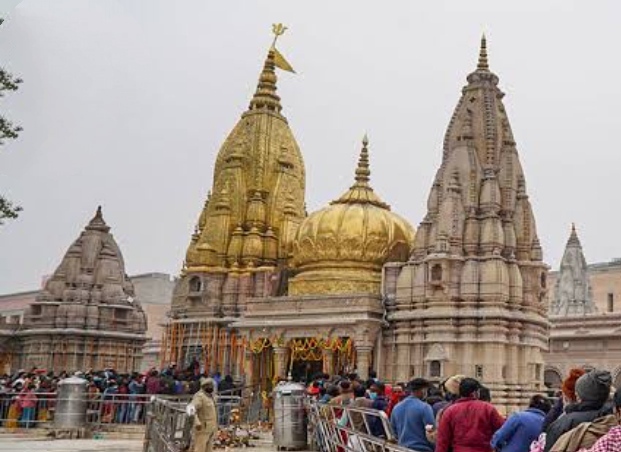
Image Credit: Mechatron00, CC BY-SA 4.0 via Wikimedia Commons
https://commons.wikimedia.org/wiki/File:Kashi_Vishwanath.jpg
8. Trimbakeshwar (Maharashtra)
If you’re exploring spiritual India, Trimbakeshwar is one spot that feels truly special. Nestled near the source of the sacred Godavari River in the quiet town of Trimbak, this Jyotirlinga is unlike any other. Why? Because its Linga has three faces — representing Brahma (the creator), Vishnu (the preserver), and Shiva (the destroyer). This symbolism alone makes it a fascinating stop for anyone curious about deeper meanings in Hindu tradition.
But Trimbakeshwar isn’t just about symbolism. It’s deeply tied to tradition and ritual. This is one of the few places where the famous Narayan-Nagbali ceremony is performed. Pilgrims come here to perform this ritual to appease ancestor souls, believing it brings peace to the departed and blessings to their family.
The temple itself is a beautiful example of Maratha architecture, built in the 18th century by Peshwa Nana Saheb. Step inside, and you’ll see the Linga carved from a single stone, about 3.6 feet tall — quiet yet powerful, surrounded by a peaceful atmosphere that seems to pull you into reflection.
And the location is perfect — with the Godavari beginning its journey here, Trimbakeshwar feels like the source of something both natural and divine. If you’re visiting, take time to walk along the ghats and soak in the serene environment. For me, it’s a place where history, ritual, and nature come together in a way that leaves you quietly changed.
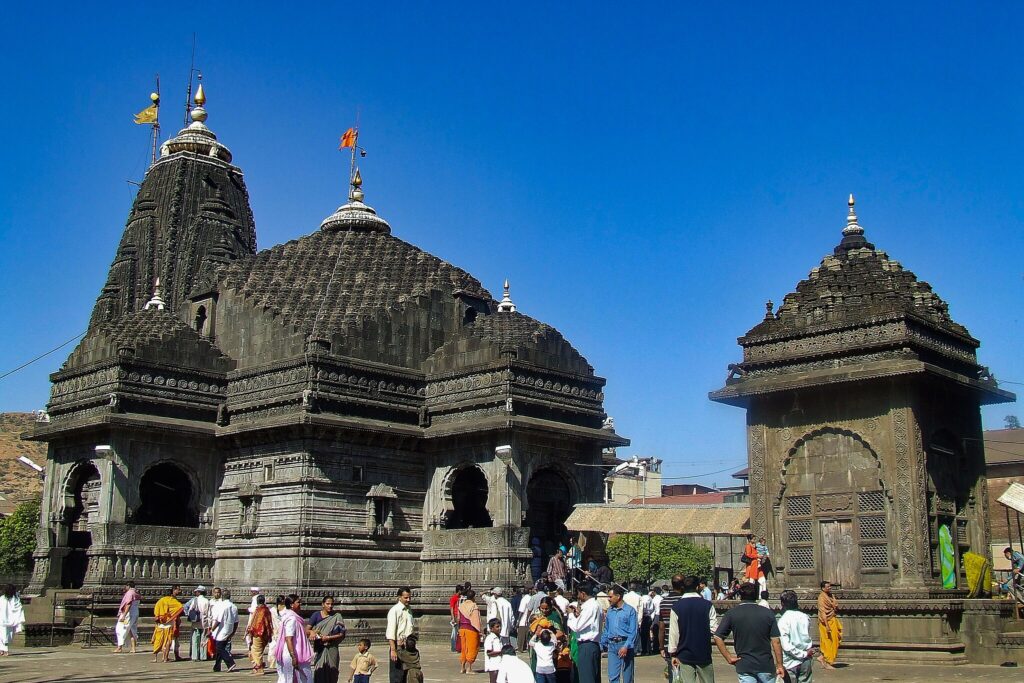
Image Credit: Saket Verma, CC BY-SA 4.0 via Wikimedia Commons
https://commons.wikimedia.org/wiki/File:Trimbakeshwar_Shiva_Temple_2005.jpg
9. Vaidyanath (Jharkhand)
If there’s a place in India where faith, legend, and healing come together, it’s Baidyanath — also known as Vaidyanath. Nestled in Deoghar, Jharkhand, this shrine isn’t just another temple; it feels like a sanctuary where people come with their deepest hopes.
There’s a beautiful story here. After Ravana performed intense penance to please Lord Shiva, he was granted healing at this very spot. That’s why Shiva here is worshipped as Vaidya — the supreme healer. For centuries, devotees have come here believing that a visit can heal wounds of the body and soul alike.
If you come during the holy month of Shravan (July–August), you’ll see the magic of Baidyanath come alive. Pilgrims pour in from across India — many walking for miles, carrying kanwars filled with Ganga water to offer to Shiva. There’s chanting, laughter, devotion, and something in the air that feels both powerful and comforting.
The temple itself is beautiful, carved with detail and history. But more than the stone walls or spire, it’s the sense of faith here that stays with you. Baidyanath isn’t just a destination — it’s a place that stays in your heart long after you’ve left.
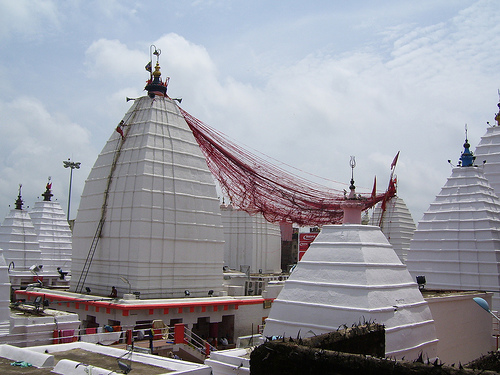
Image Credit: onkardkhandalikar, CC BY-SA 4.0 via Wikimedia Commons
https://commons.wikimedia.org/wiki/File:Baba_Dham.jpg
10. Nageshwar (Gujarat)
If you ever visit Dwarka, don’t miss a short trip to Nageshwar, one of the twelve Jyotirlingas. Nestled close to the coast, this shrine has a vibe that feels both powerful and peaceful — like standing before something ancient yet alive.
The name “Nageshwar” itself tells a story. “Naag” means serpent, and this temple is dedicated to Shiva as the protector from evil forces and poison. Legend says that Shiva here guards devotees against hidden dangers, both seen and unseen, offering them courage and strength.
Inside, the temple houses a striking, larger-than-life statue of Shiva that immediately grabs your attention. But beyond its grandeur, Nageshwar stands as a symbol — not just of protection, but of fearlessness and inner strength. Many pilgrims say visiting here leaves them with a quiet courage they didn’t have before.
If you walk around the temple, you’ll notice an energy that feels almost alive, as if the place itself is quietly whispering: “Be fearless, for you are never truly alone.”

Image Credit: Emmanuel DYAN from Paris, France, CC BY 2.0 via Wikimedia Commons https://commons.wikimedia.org/wiki/File:Nageshwar_Mahadev,Shiva_Temple,_Gujarat–India(3409894210).jpg
11. Rameshwaram (Tamil Nadu)
If you ever travel to the southern tip of India, Rameshwaram is a place that stays with you. It’s not just a temple, it’s a story etched in stone, faith, and devotion. Sitting there on its island, surrounded by the sea, it almost feels like a quiet meeting point between heaven and earth.
The legend here is beautiful. It’s said that Lord Rama installed the Shiva Linga at Rameshwaram before crossing over to Lanka for the war in the Ramayana. That’s why this place is special — it blends Shaiva and Vaishnava traditions, a rare harmony in the world of temples.
The temple itself is awe-inspiring. Its corridors are some of the longest in India, and walking through them feels like stepping into centuries of devotion. Inside, there are 22 holy wells, each with its own story, where pilgrims bathe believing it purifies not just the body but the soul.
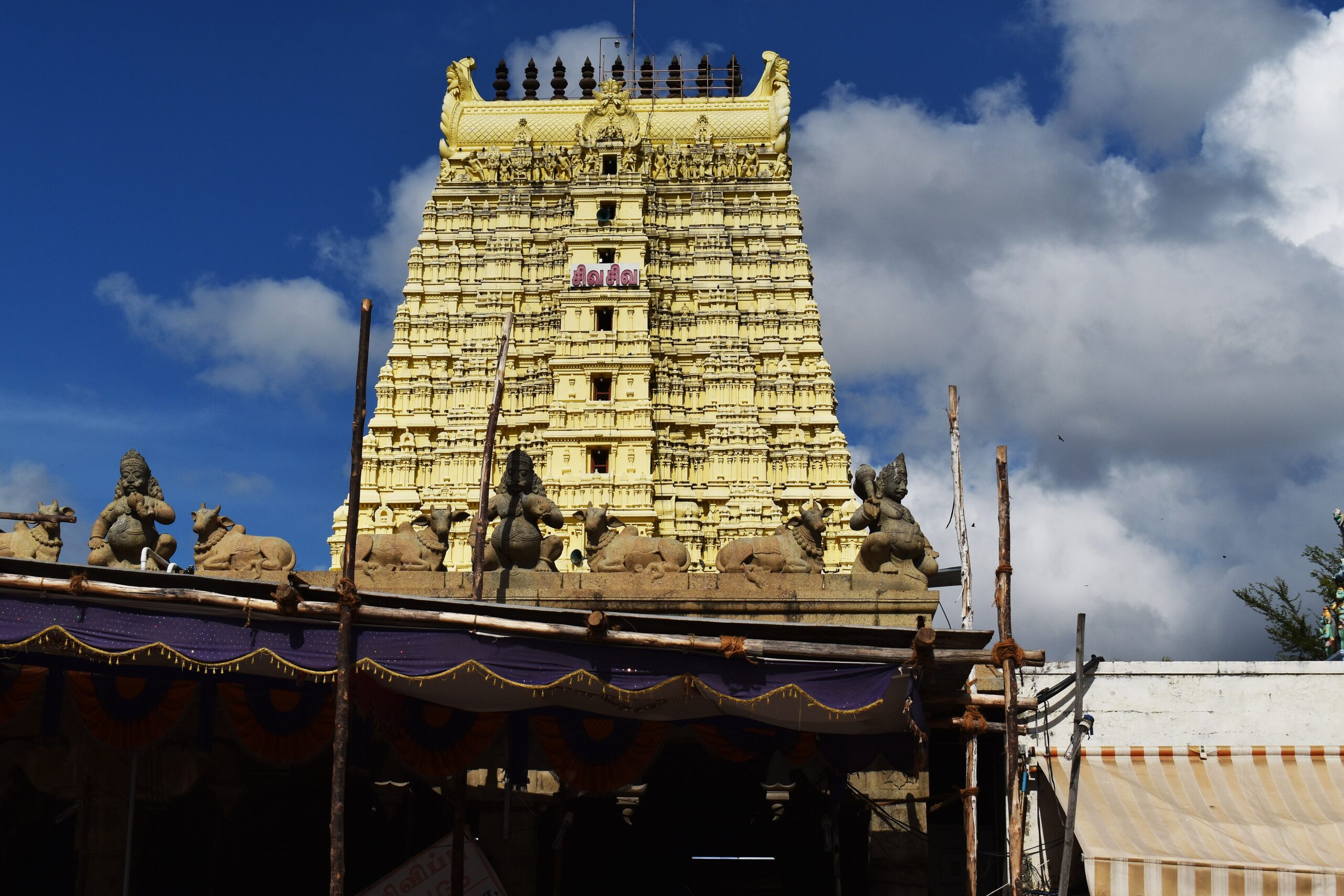
Image Credit: Wanderlusts, CC BY-SA 4.0 via Wikimedia Commons
https://commons.wikimedia.org/wiki/File:Ramanathaswamy_Temple,_Rameshwaram,_Tamil_Nadu.jpg
12. Grishneshwar (Maharashtra)
Grishneshwar is one of those places that quietly surprises you. It’s small, tucked away near the famous Ellora Caves, and honestly, if you’re not paying attention, you might miss it. But that’s part of its charm — it feels like a hidden gem.
The story here is touching. A woman named Ghushma prayed to Shiva with such sincerity that he appeared before her and blessed her. Out of gratitude, she built this temple. So, unlike some grand monuments, Grishneshwar feels deeply personal — almost like a quiet prayer turned into stone.
When you walk in, it’s not about overwhelming grandeur. It’s calm. The carvings are simple, yet full of warmth. The air feels softer. You might catch yourself slowing down, without even meaning to. People often say visiting here feels less like visiting a temple and more like finding a quiet corner for your soul.
If you’re in Aurangabad or heading to the Ellora Caves, give yourself time to stop here. Stand in silence, breathe in the air, listen to the soft hum of chants. Somehow, you walk away feeling lighter — like the place quietly stays with you.

Image Credit: Wanderlusts, CC BY-SA 4.0 via Wikimedia Commons https://commons.wikimedia.org/wiki/
File:Grishneshwar_temple,_Jyotirlinga_shrine,_at_Aurangabad_Maharashtra.jpg
Each Jyotirlinga is more than a temple—it is a spiritual beacon, inviting seekers to connect with the infinite.
Beyond the Shrines: Power, Practice and Presence
If you look at a map of India, you’ll notice something special — the twelve Jyotirlingas are spread across the country almost like a spiritual trail. Many people believe they form a kind of energy map for Bharat, similar to how chakras work in the human body. Some traditions even connect each Jyotirlinga to a zodiac sign. It’s a beautiful thought — that these temples aren’t just places, but living points where the divine and the cosmos meet.
Visiting a Jyotirlinga is not just about seeing a temple — it’s about feeling it. There’s a rhythm to it: the fasts during the holy month of Shravan, offering bilva leaves, performing Abhishekam (ritual bathing of the Linga), and chanting mantras that have echoed for centuries. And then there’s Maha Shivratri — a day when millions gather, turning the temples into flowing rivers of devotion. It’s an experience unlike any other.
Jyotirlingas are woven deeply into India’s culture. They have inspired art, music, poetry, and architecture. Temples like Kashi Vishwanath and Rameshwaram are more than pilgrimage sites — they are living cultural treasures that continue to inspire generations of travellers and seekers.
Today, going on a pilgrimage has become much easier. Roads are better, there’s online darshan, guided tours, and plenty of travel options. But for many, the journey is about more than convenience. Whether it’s the steep trek to Kedarnath or walking through the majestic corridors of Somnath, visiting a Jyotirlinga becomes an inner journey too — a quiet moment of faith and transformation.
At the heart of it, the Jyotirlingas point us inward. Their light is a simple but powerful reminder: the divine isn’t far away. It’s right here, within us — steady, sacred, and quietly shining, even in the chaos of everyday life.
“Explore more divine stories and ancient wisdom: Whispers of Bharat.”



